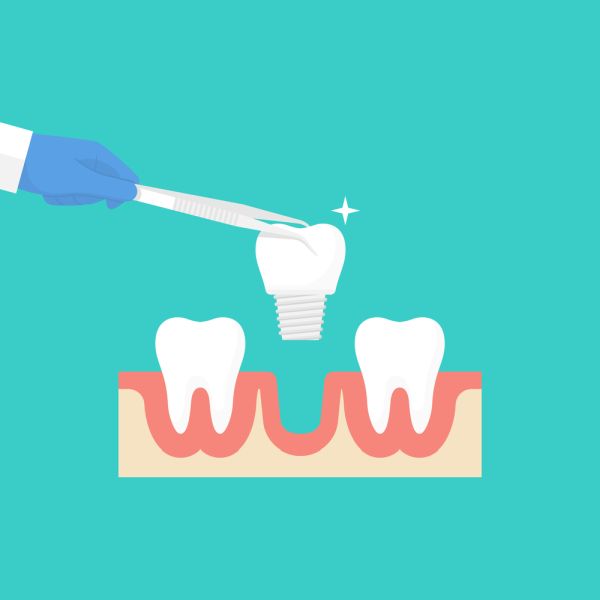4 Signs You May Need to Replace a Dental Implant Crown

The most popular restoration placed atop a dental implant is a crown. Crowns are sturdy, tooth-shaped caps that are used to either restore an existing tooth or top a dental implant. Although durable, crowns are designed to act like natural teeth and can, therefore, experience wear and damage.
Dental implants are typically made up of three separate parts to a whole. The implant post acts as tooth roots, the abutment is a peg connecting the post to restoration, and the top part of the implant is known as the restoration, usually a crown. Implants themselves are virtually immune to decay, as they are made from materials fabricated in a lab (usually porcelain, metal, or a combination of both). Even though they are resistant to decay, dental implant crowns can still be damaged by other factors.
When is it time to replace a dental implant crown?
If your dental implant crown shows any of these 4 signs, it might be time to replace it.
Cracked crowns
Extensive wear can occur on a dental implant crown over a long period of time. Most crowns are designed to last 10 to 15 years on average, not accounting for crowns damaged by any sudden trauma. Like teeth, crowns are still susceptible to damage. Crowns can be cracked when biting down on a hard object, during sports accidents and any injury to the mouth.
After years of use, tiny fractures can form in a crown. Bruxism, a condition where someone grinds or clenches their teeth unconsciously can cause a crown to fail even sooner. These tiny fractures can weaken the implant crown, making it vulnerable to bigger cracks.
For patients whose teeth do not fit together correctly (a condition known as malocclusion), wear can occur quicker on the surface of the dental implant crown. Those with malocclusion typically experience early crown wear.
Gum tissue recession
Plaque tends to gather around the base of crowns when they are not properly cared for. Even against best efforts, tartar can build up at the gumline. Brushing and flossing daily, along with frequent dental cleanings are crucial in the longevity of a dental implant crown. Plaque cannot affect porcelain, but the acid produced by the bacteria within plaque can still eat away at the gums.
If left untreated, bacteria can begin to destroy gum tissue. This is known as gum recession. The gums start to pull back from the implant crown, and a dark line may appear. Regular dental checkups will help the dentist to determine any signs of gum recession before it becomes a bigger problem.
Infected gum tissue
Those with dental implants may need professional dental cleanings more often than patients without a crown. If not cleared, the bacteria at the gumline can then reach the jawbone and cause some major destruction. Eventually, an abscess may form at the base of the implant. The jawbone will start to lose density, and can even threaten the integrity of the dental implant.
Instead of having to replace the entire implant at this stage, the dentist may recommend replacing only the crown at the first sign of seriously infected gum tissue.
Loose crown
Sometimes, crowns can loosen. If the bonding material connecting the crown to abutment fails, the crown may need to be replaced. Loose crowns may cause a clicking sound when chewing or speaking.
Care for your crown
Dental implant crowns require the same level of care as natural teeth. If you suspect something is off about your implant crown or the gum tissue around it, visit your dentist right away to ensure the problem does not worsen.
Request an appointment here: https://www.smilesbyjulia.com or call Smiles By Julia at (954) 493-6556 for an appointment in our Fort Lauderdale office.
Check out what others are saying about our services on Yelp: Read our Yelp reviews.
Related Posts
Dental veneers are thin pieces of porcelain that are designed to mimic the appearance of natural teeth. To maximize their effectiveness, patients should learn how to care for them. These appliances are used to enhance the appearance of the smile by covering flaws, such as broken, discolored, chipped, or gapped teeth. With proper care, such…
Veneers are artificial shells placed on the surface of teeth to cover up a number of cosmetic issues. Patients who have cosmetic problems, whether teeth are chipped, cracked, stained, or too small, frequently hide these imperfections by not smiling. This can impact self-confidence and affect a person’s daily quality of life. A patient with a…
Dental veneers can be used to cover gapped, misaligned, or stained teeth. These permanent tooth coverings are made out of a variety of materials, the most common being porcelain, allowing for a cosmetic solution that does not require special care beyond basic dental hygiene and can last up to 15 years. Find out how this…
Many dental patients turn to veneers to help fix their smiles. This popular treatment option is able to correct many minor issues with the teeth and is an easy procedure that can quickly enhance a smile’s appearance.The following are questions that patients frequently ask about veneers:Veneers are not considered permanent, but are long-lasting. They usually…
